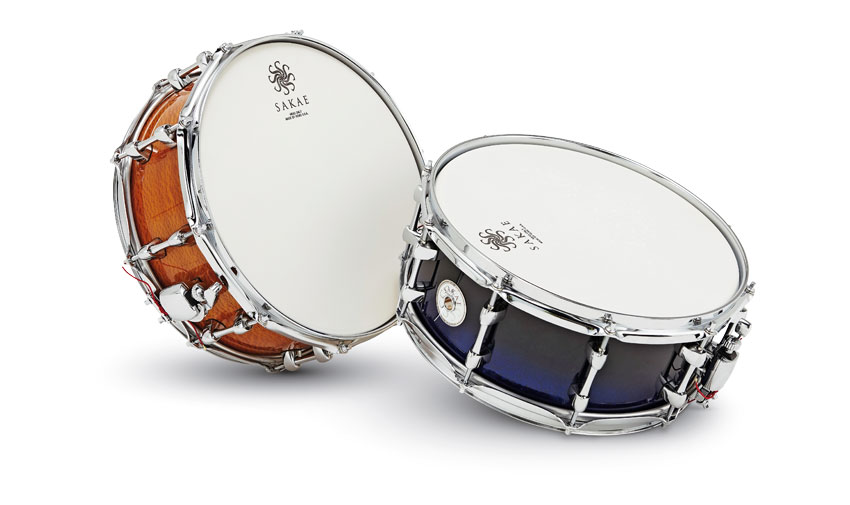MusicRadar Verdict
Beautifully hand-made snares in surprisingly under-used beech wood. Shell construction not as radical as the Trilogy series, but equally well made. Ultra-smooth throw-off is one of the best around.
Pros
- +
Excellent construction. Good quality components. Warm, clear tones.
Cons
- -
Tension knob is fiddly.
MusicRadar's got your back
Sakae is the exciting new name on the drum scene, the Japanese company which has actually made drums since 1925 and exclusively built Yamaha's high-end drums from 1967 up until last year. We reviewed the new Sakae Trilogy kit back in January, now it's the turn of the firm's beech snare.
Build
The two snares reviewed here are essentially the same instrument with different finishes. They both have eight-ply beech shells, but one is in black-to-blue sparkling acrylic lacquered gloss, while the other has an extra veneer of silky oak - in total, there's a choice of 27 eye-catching finishes. The black-blue is 8-ply and 6.4mm thick, while the silky oak is 9-ply and 6.6mm thick.
Unlike the Trilogy kit, which has vintage 3-ply shells with reinforcing rings, these snares have familiar Sakae-Yamaha style shells with angled butt seams and no reinforcing rings.
"The insides are gorgeous pale reddish brown, horizontally laid and prettily-patterned beech wood"
The bearing edges are 45° leading up to a fairly sharp point and they are precisely cut. The insides are gorgeous pale reddish brown, horizontally laid and prettily-patterned beech wood, with no glitches anywhere. They are lightly sealed with a tiny bit of nap left and are accurately round. An inner hand-signed and dated paper slip states, 'Sakae, Beech Shell, Since 1925, Hand Made in Japan'.
Both drums came with 2.3mm triple- flanged steel hoops with the top flange turned out in the normal manner. Sakae calls these hoops Righty Halo, but you can also have similar hoops with the top flange turned inwards (vintage Slingerland fashion), called Mighty Halo. There are 20 small lugs planted on the thinnest of black nylon gaskets, joined by thick, waisted bridge rods.
Which just leaves the strainer. Now a snare drum is not the most complex of devices. It is not exactly a BMW car. There is just one mechanical gadget, which involves two operations: the strainer for engaging the snares, and the tension knob to alter their tension. After 100 years of evolution it amazes us how often this throw-off/strainer is a dud. Well Sakae has got it almost right. The throw-off bit is fabulously smooth. But it's slightly let down by an all-too-common small knurled tension knob which is fiddlier to turn than it should be.
How Sakae has made the lever so smooth becomes evident when you examine the mechanism. The contoured lever is hinged onto a cam action which throws the lever out from the centre in a wide arc. Inside the strainer plate there is a greased plastic block which travels up and down, easing the lever motion. When the block reaches the top the lever still has to be pushed further on its cam, in an effortlessly smooth locking snap. Believe us, it's a smoothy.
Hands On
"What you get is consistent all-round-the-edge clarity courtesy of the accurately cut bearing edges"
Since the only difference between the two drums is that one has a wood veneer and the other a sparkle lacquer, it was fun to tune them differently and play them side-by-side. They both arrived feeling uptight - a Zigaboo sound with both the resonant head and snares tight, resulting in a harsh crunch. But although slightly choked the underlying tone was still good. So the first thing was to loosen the bottom heads and snares, allowing the drums to breath, opening up the already promising timbre.
From here we started with one batter tuned extra low and the other extra high, ie: at the extremes. They both held their tuning well and didn't feel uncomfortable, a positive attribute for any drum. What you get is consistent all-round-the-edge clarity courtesy of the accurately cut bearing edges, and a plump tone courtesy of the succulent beech shell. The sound in the centre remains snarey always, with no dead spots. The good quality snare wires help here.
Add to this a healthy resonance from the metal hoops and the stout-ish 8-ply shell - a piercing ring which you may need to control, but which shows how lively the drums are. As we gradually tuned them closer towards each other the overall tone remained fat for 51⁄2" shells.
Beech is a great wood for drums, underused we reckon, as attractive and with as much character as birch or maple. If pushed we'd say that beech was slightly softer/warmer than either of the more common woods.
“A synthesizer that is both easy to use and fun to play whilst maintaining a decent degree of programming depth and flexibility”: PWM Mantis review
“I feel like that song had everything we needed to come back with”: Bring Me The Horizon’s Lee Malia on Shadow Moses, its riff and the secrets behind its tone, and why it was the right anthem at the right time
“I said, ‘Are we sure we can write a song about death?’”: The story of Mike + The Mechanics' classic No.1 The Living Years










